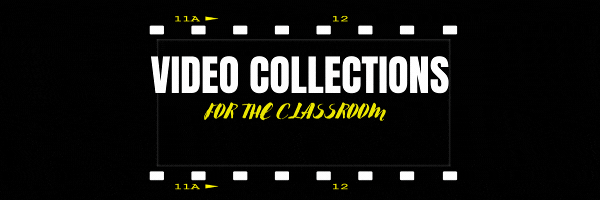Category: Videos
17 Video Creation Online Tools
- Adobe Spark–suite of free tools for creating images, videos, and simple web pages; quick; great for Chromebooks
- Animoto
- Canva video creator–How-to video by Richard Byrne
- Chromebook–use Chromebook’s native video creation tool; watch this video on how; no add-ons or apps.
- EdPuzzle–edit, quizzify, and add your voice to any video
- Go animate
- Headliner–browser-based video editor; ed version; freemium
- Moovly–free or fee, animated videos
- PlayPosit–interactive videos
- Spark video — works on Chromebooks and iOS; add personal narrative, images. Use a story template or start from scratch; creates as slides
- Unscreen–remove background in videos for free
- Video Editor--free with Windows 10
- Vimeo
- Voki
- WeVideo–collaborative; record on mobile devices; edit on desktop; works great on Chromebooks
- Wideo–create videos online
- Windows 10 organic video editor–how-to video to turn photos into video by Richard Byrne
Share this:
- Click to share on Facebook (Opens in new window) Facebook
- Click to share on X (Opens in new window) X
- Click to share on LinkedIn (Opens in new window) LinkedIn
- Click to share on Pinterest (Opens in new window) Pinterest
- Click to share on Telegram (Opens in new window) Telegram
- Click to email a link to a friend (Opens in new window) Email
- More
Teacher-Authors: What’s Happening on my Writer’s Blog
A lot of teacher-authors read my WordDreams blog. In this monthly column, I share the most popular post from the past month:
What Should You Know About Interactive Storytelling?
Here’s what I cover:
- What is it?
- How can writers use it?
- Advantages
- Disadvantages
What is interactive storytelling
Interactive storytelling is a growing trend that allows readers to actively participate in shaping the narrative. With advancements in augmented and virtual reality, stories are no longer confined to the pages of a book. Authors can provide immersive experiences and create narratives that respond to reader choices.
Interactive storytelling allows the audience to actively shape the story rather than passively consume it. Unlike traditional storytelling with a fixed plot, interactive stories let users influence the direction, outcomes, and details through their choices and input. It blends creativity with technology, making each telling unique. 81% of marketers agree interactive content grabs attention more effectively and 66% admit it increases audience engagement. I can attest to this popularity. As a teacher, I occasionally asked students to choose from among several story endings or create their own. A good example is Mission USA, a website that uses interactive storytelling to teach historic events such as the American Revolution, Civil Rights, the Great Depression, and more:

Students click into one of the stories and are asked to make decisions similar to those made during that time period and then experience the consequences of their choices–whether the Loyalists or Tories won, how a family survived (or didn’t) the Great Depression, or something else. Here’s a video to explain it:
[youtube https://www.youtube.com/watch?v=Kb_te-MmM04?si=v9ZG8x8n6TjCGMgk]
Another example many will remember is Oregon Trail where participants were expected to stock their Conestoga wagon to head to the Oregon territories (or California). Along the way, they made decisions such as whether to purchase mules vs. oxen, how to ford a river, how to cure diseases and injuries, and more. Their selections ultimately determined if they survived.
How can writers use interactive storytelling
Share this:
- Click to share on Facebook (Opens in new window) Facebook
- Click to share on X (Opens in new window) X
- Click to share on LinkedIn (Opens in new window) LinkedIn
- Click to share on Pinterest (Opens in new window) Pinterest
- Click to share on Telegram (Opens in new window) Telegram
- Click to email a link to a friend (Opens in new window) Email
- More
25+ Video Collections
 Here are some excellent themed video collections to use in your classroom (click here for updates on the list): (more…)
Here are some excellent themed video collections to use in your classroom (click here for updates on the list): (more…)
Share this:
- Click to share on Facebook (Opens in new window) Facebook
- Click to share on X (Opens in new window) X
- Click to share on LinkedIn (Opens in new window) LinkedIn
- Click to share on Pinterest (Opens in new window) Pinterest
- Click to share on Telegram (Opens in new window) Telegram
- Click to email a link to a friend (Opens in new window) Email
- More
How to use Digital Quick Writes–the video
How to use Digital Quick Writes
This video is from a series I taught for school districts. It is now available for free, here on Ask a Tech Teacher:
–summarized by NoteGPT
Summary
In this video, Jacqui Murray discusses the concept of “quick writes” as a dynamic and engaging way to teach writing in the classroom. Quick writes are short, spontaneous writing exercises that allow students to express their thoughts and ideas without the pressure of formal writing tasks. Murray emphasizes the importance of variety and choice in writing activities, which can cater to students’ different preferences and skills. By integrating technology and allowing students to use a range of mediums—such as audio, visual, and written forms—quick writes not only reinforce writing skills but also enhance problem-solving, creative thinking, and communication abilities. The video outlines practical strategies for implementing quick writes in the classroom, provides examples of tools and techniques, and highlights how these exercises can meet Common Core standards. Overall, Murray advocates for a process-oriented approach to writing, focusing on student engagement and skill development rather than the final product.
Highlights
- ✍️ Dynamic Writing Experience: Quick writes offer an engaging alternative to traditional writing assignments, allowing students to express themselves freely.
- 🌍 Integration of Technology: Incorporating various digital tools enhances the writing experience and fosters creativity among students.
- 🎨 Variety of Mediums: Students can choose from multiple formats—writing, drawing, audio—to communicate their ideas effectively.
- 🕒 Short and Focused: Quick writes typically last 10-15 minutes, encouraging concise and thoughtful expression of ideas.
- 📢 Process Over Product: The focus is on the writing process and student effort rather than the final outcome, promoting a growth mindset.
- 📚 Alignment with Common Core: Quick writes can be tailored to meet various educational standards, making them versatile across subjects.
- 🤝 Collaborative Learning: Sharing and discussing quick writes with peers enhances understanding and communication skills.
Key Insights
- 📅 Flexibility in Timing: Quick writes can be integrated into any part of a lesson, making them adaptable to various subjects and topics. This flexibility allows teachers to connect writing with ongoing projects or discussions, reinforcing the relevance of writing in different contexts.
- 💡 Choice Empowers Students: By providing students with options for how they want to express their ideas—be it through writing, drawing, or using multimedia—teachers can cater to diverse learning styles. This choice not only fosters engagement but also encourages students to take ownership of their learning process.
- 🛠️ Technological Proficiency: Incorporating digital tools and platforms into quick writes helps students become more comfortable with technology. This not only prepares them for future academic challenges but also equips them with essential skills for the modern workforce.
- 🎯 Focus on Skill Development: Quick writes emphasize the importance of developing writing skills through practice rather than perfection. By creating a low-stakes environment where effort and process are prioritized, students are more likely to take risks and experiment with their writing.
- 🤔 Critical Thinking and Problem Solving: Engaging in quick writes requires students to think critically and solve problems quickly, especially when using new technologies or formats. This process aligns with educational standards that emphasize critical thinking as a vital skill for success.
- 📝 Assessment for Learning: Instead of grading the final product, teachers assess students based on their effort and engagement during quick writes. This formative assessment approach allows for ongoing feedback and supports a learning environment focused on growth rather than competition.
- 🎉 Fun and Engagement: Quick writes can be a fun way to break up traditional lessons, making writing enjoyable for students who may otherwise find it daunting. By incorporating games and creative formats, teachers can foster a love for writing that extends beyond the classroom.
Conclusion
Jacqui Murray’s discussion on quick writes highlights the importance of innovative and flexible writing practices in education. By integrating technology, allowing for student choice, and emphasizing the writing process, educators can create a more engaging and effective writing experience. Quick writes serve as a powerful tool to develop not only writing skills but also critical thinking, problem-solving, and collaboration—all of which are essential for students in today’s world. Through this approach, teachers can foster a classroom environment that values creativity, encourages exploration, and supports skill development for all learners.
Share this:
- Click to share on Facebook (Opens in new window) Facebook
- Click to share on X (Opens in new window) X
- Click to share on LinkedIn (Opens in new window) LinkedIn
- Click to share on Pinterest (Opens in new window) Pinterest
- Click to share on Telegram (Opens in new window) Telegram
- Click to email a link to a friend (Opens in new window) Email
- More
4 Critical Pieces of Every Lesson and How to Gamify Them–the video
Gamification of Education
This video is from a series I taught for school districts. It is now available for free, here on Ask a Tech Teacher:
–summarize with NoteGPT
Summary
Jacqui Murray discusses the integration of technology in K-8 education, focusing on gamification to enhance learning.
Highlights
- 🎮 Gamification enhances learning by incorporating game elements into education.
- 💻 Keyboarding skills are essential for students in a technology-driven world.
- 📚 Vocabulary building is crucial across all subjects for comprehension.
- 🌐 Digital citizenship teaches safe online practices for students.
- 🔍 Research skills promote inquiry and curiosity in students.
- 🏗️ Games like Minecraft and Sim City can teach complex subjects effectively.
- 📈 Engaging students through games can improve retention and understanding.
Key Insights
- 🎓 Gamification is a powerful tool that transforms traditional learning into interactive experiences, making education more appealing to students. This approach fosters engagement and motivation, which are essential for effective learning.
- ⌨️ Mastery of keyboarding is critical, as students will be tested on these skills. Teaching proper keyboarding habits at an early age helps ensure students can focus on content rather than mechanics, supporting their overall academic performance.
- 🔠 A strong vocabulary is foundational for academic success. By encouraging students to decode unfamiliar words in context, educators enhance comprehension and prepare them for standardized assessments.
- 🛡️ Digital citizenship education is essential as students navigate online environments. Teaching them about online safety and responsibility ensures they can engage positively and productively in digital spaces.
- 🔍 Encouraging research and inquiry through dedicated projects like Genius Hour fosters a sense of ownership in learning, allowing students to pursue their interests and develop critical thinking skills.
- ⚙️ Education-focused games must have narrative and character development to be effective. When students engage with games that require problem-solving and critical thinking, they learn necessary academic concepts in a fun way.
- 📊 Statistics show that a significant number of people engage with games regularly. Leveraging this interest in gaming can bridge the gap between entertainment and education, creating a dynamic learning environment that resonates with students.
This video is from a series I taught for school districts. It is now available for free, here on Ask a Tech Teacher. It includes videos on: (more…)
Share this:
- Click to share on Facebook (Opens in new window) Facebook
- Click to share on X (Opens in new window) X
- Click to share on LinkedIn (Opens in new window) LinkedIn
- Click to share on Pinterest (Opens in new window) Pinterest
- Click to share on Telegram (Opens in new window) Telegram
- Click to email a link to a friend (Opens in new window) Email
- More
Teach Speaking and Listening Skills with Student Presentations–the video
Teach Speaking and Listening Skills with Student Presentations
This video is from a series I taught for school districts. It is now available for free to Ask a Tech Teacher subscribers:
Summary
This video discusses using student presentations to enhance speaking and listening skills, aligning with Common Core standards. (more…)
Share this:
- Click to share on Facebook (Opens in new window) Facebook
- Click to share on X (Opens in new window) X
- Click to share on LinkedIn (Opens in new window) LinkedIn
- Click to share on Pinterest (Opens in new window) Pinterest
- Click to share on Telegram (Opens in new window) Telegram
- Click to email a link to a friend (Opens in new window) Email
- More
Digital Citizenship Week: What to Teach When–a video
Digital Citizenship Week — October 14–18, 2024
You can get a lot of great ideas from Common Sense Education on their Digital Citizenship Week page:
- Digital Citizenship Week calendars, with fun activities and suggested lessons for each day
- AI literacy resources, like AI foundations course for educators, and AI literacy lesson collection for students
- Webinars and events to help build your teaching practice and implement digital citizenship in your classroom
- Family engagement resources to share in your community
Here at Ask a Tech Teacher, we invite you to watch a great video (40 minutes) we use in training, available for free today to Ask a Tech Teacher readers–
Digital Citizenship: What to Teach When
Summary
Share this:
- Click to share on Facebook (Opens in new window) Facebook
- Click to share on X (Opens in new window) X
- Click to share on LinkedIn (Opens in new window) LinkedIn
- Click to share on Pinterest (Opens in new window) Pinterest
- Click to share on Telegram (Opens in new window) Telegram
- Click to email a link to a friend (Opens in new window) Email
- More
Warm-ups–Watch the video
Warm-ups
This video is from a series I taught for school districts. It is now available for free, here on Ask a Tech Teacher:
–summarized by NoteGPT
Highlights
- 🖥️ Engaging with technology enhances student learning and excitement.
- 📅 Class warm-ups help transition students into learning mode efficiently.
- ⏱️ Student independence during warm-ups allows teachers to manage other tasks.
- 🎨 Utilizing tools like Smore for creating engaging class materials.
- 📚 Presentation boards encourage student collaboration and sharing.
- 💻 Blogging fosters communication and feedback among classmates.
- 🔄 Responsive classroom activities can be adapted for technology use.
Key Insights
- 🧑🏫 Technology Integration: Effectively using technology in education not only captivates students but also promotes a deeper understanding of the material. Encouraging tech-related engagement can transform traditional lessons into interactive experiences.
- 🎯 Purposeful Warm-Ups: Implementing structured class warm-ups minimizes downtime and maximizes learning. These activities set the tone for the lesson and help students focus as they transition into the learning environment.
- 🤝 Student Empowerment: Allowing students to take charge of their warm-up activities fosters independence. This approach not only builds responsibility but also encourages them to become active participants in their learning journey.
- 📊 Creative Teaching Tools: Utilizing platforms like Smore helps educators design visually appealing and informative materials that enhance communication with students and parents, making learning more accessible.
- 👥 Collaborative Learning: Activities such as presentation boards and blogging promote peer-to-peer learning. This collaboration strengthens their understanding and retention of the material while building a supportive classroom community.
- 🔄 Feedback Mechanisms: Incorporating blog comments or discussion forum posts enables meaningful interaction. This feedback loop enhances the learning process and encourages critical thinking among students.
- 🏫 Responsive Classroom Strategies: Integrating responsive classroom techniques with technology can create an inclusive and engaging learning environment. These strategies help maintain student interest and facilitate smooth transitions during lessons.
Share this:
- Click to share on Facebook (Opens in new window) Facebook
- Click to share on X (Opens in new window) X
- Click to share on LinkedIn (Opens in new window) LinkedIn
- Click to share on Pinterest (Opens in new window) Pinterest
- Click to share on Telegram (Opens in new window) Telegram
- Click to email a link to a friend (Opens in new window) Email
- More
18 Digital Tool Musts in the Classroom — a Video
18 Digital Tool Musts in the Classroom
This video is from a series I taught for school districts. It is now available for free, here on Ask a Tech Teacher:
Summary
18 essential digital tools for classrooms, emphasizing their impact on modern education.
Highlights
- ✏️ Annotation Tools: Essential for digital note-taking.
- 👤 Avatars: Promote digital citizenship and privacy.
- 💬 Backchannel Devices: Enhance classroom communication.
- 🗓️ Class Calendars: Keep students organized and informed.
- 🌐 Class Websites: Centralize classroom resources and communication.
- 📚 Digital Portfolios: Collect and showcase student work.
- 📊 Online Quizzes: Provide fun and quick assessments.
Key Insights
- 📝 Annotation tools like Notability and Adobe Acrobat empower students to engage with digital texts actively, fostering comprehension and retention.
- 🎨 Using avatars instead of personal images encourages student privacy and encourages creativity in digital representation, reinforcing digital citizenship principles.
- 🌍 Backchannel communication tools like Padlet and Twitter create a collaborative classroom environment where students can ask questions and share ideas in real time.
- 📅 Integrating class calendars keeps students accountable and involved in managing their schedules, enhancing organizational skills from an early age.
- 🖥️ Class websites serve as a hub for resources, helping parents and students stay connected and informed about class activities and expectations.
- 📂 Digital portfolios allow students to curate their work, promoting self-reflection and ownership of their learning journey while simplifying the grading process for teachers.
- 🎉 Online quizzes not only engage students but also provide instant feedback, enabling educators to identify learning gaps and adjust instruction accordingly.
–summarized by NoteGPT
This video is from a series I taught for school districts. It is now available for free to Ask a Tech Teacher subscribers. Videos include (in alphabetic order):
- 15 Webtools in 15 Weeks
- 18 Digital Tools in the Classroom
- A focus on strategies
- Alternative tools
- Assessment isn’t static
- Author doers
- BYOD
- Class warm-ups
- Collaboration
- Curriuculum Maps
- Differentiation–How to teach the hard-to-teach class
- Digital Citizenship: What to Teach When
- Flipping the classroom
- Gamification of education
- How to Teach a Tech Lesson
- Presentation Boards
- Tech-infused classroom
- Tech tools
- The 20% rule
- Using backchannel devices
- Warm-ups
Here’s the sign-up link if the image above doesn’t work:
https://forms.aweber.com/form/07/1910174607.htm
“The content presented in this blog are the result of creative imagination and not intended for use, reproduction, or incorporation into any artificial intelligence training or machine learning systems without prior written consent from the author.”
Jacqui Murray has been teaching K-18 technology for 30 years. She is the editor/author of over a hundred tech ed resources including a K-12 technology curriculum, K-8 keyboard curriculum, K-8 Digital Citizenship curriculum. She is an adjunct professor in tech ed, Master Teacher, webmaster for four blogs, freelance journalist on tech ed topics, contributor to NEA Today, and author of the tech thrillers, To Hunt a Sub and Twenty-four Days. You can find her resources at Structured Learning.
Share this:
- Click to share on Facebook (Opens in new window) Facebook
- Click to share on X (Opens in new window) X
- Click to share on LinkedIn (Opens in new window) LinkedIn
- Click to share on Pinterest (Opens in new window) Pinterest
- Click to share on Telegram (Opens in new window) Telegram
- Click to email a link to a friend (Opens in new window) Email
- More
Creating and Using Curriculum Maps Video
Creating and Using Curriculum Maps
This video is from a series I taught for school districts. It is now available for free, here on Ask a Tech Teacher:
Summary
Use technology for effective curriculum mapping in lesson planning, emphasizing its importance and ongoing updates.
Highlights
- 📚 Curriculum maps help organize teaching and enhance collaboration.
- 🔄 They are dynamic documents that require constant updates.
- 🗺️ A curriculum map serves as a guide for teachers and substitutes.
- 📅 It includes essential details like timelines, skills, and assessments.
- ✏️ Creating a curriculum map is a year-long process requiring collaboration.
- 💻 Technology tools can simplify the mapping process significantly.
- 🌱 A well-structured map evolves over time, improving lesson effectiveness.
Key Insights
- 📖 Curriculum Maps Enhance Clarity: They provide a structured overview of what is taught throughout the year, benefiting both teachers and students by clarifying expectations and content.
- 🤝 Collaboration is Key: Involving all teachers in the mapping process fosters teamwork and ensures that all perspectives are considered, leading to a more comprehensive educational approach.
- 🔄 Living Documents: Curriculum maps should be treated as evolving tools that adapt based on reflections and experiences from previous years, making them more effective over time.
- 📅 Planning with Purpose: Incorporating important dates and events into the curriculum maps allows teachers to create realistic and achievable goals for their lessons.
- 💻 Technology Integration: Using digital tools to create curriculum maps can streamline the process, allowing for better organization and easier sharing among educators.
- ⏳ Long-Term Investment: Developing a thorough curriculum map is a time-consuming process, but the long-term benefits for lesson planning and execution are invaluable.
- 🌟 Reflective Practice: Regularly reviewing and updating the curriculum map encourages reflective teaching practices, helping educators identify areas for improvement and celebrate successes.
–summarized by NoteGPT
This video is from a series I taught for school districts. It is now available for free to Ask a Tech Teacher subscribers. Videos include (in alphabetic order): (more…)
Share this:
- Click to share on Facebook (Opens in new window) Facebook
- Click to share on X (Opens in new window) X
- Click to share on LinkedIn (Opens in new window) LinkedIn
- Click to share on Pinterest (Opens in new window) Pinterest
- Click to share on Telegram (Opens in new window) Telegram
- Click to email a link to a friend (Opens in new window) Email
- More








































